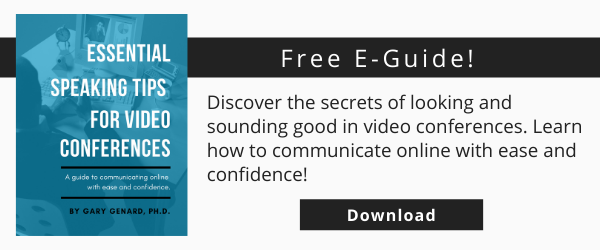Want to develop more online presence and influence? Here are some essential body language tips on how to look great in virtual meetings.
We all know how important body language is when it comes to sensing people's attitudes and feelings. Not surprisingly, research in this area has focused on in-person and not virtual interactions. And it's mostly been about what someone is showing as they respond to you.
But for years now, I've been writing about the other side: what you do as a speaker that gives audiences clues about who you are.
Do you speak with the voice of leadership? Get my Free ebook, "High-Impact Speaking: The Leader's Guide to Presenting With Integrity And Influence."
Now that online meetings are so important, a reset is in order. We need to know what works in the video world. Body language, like video itself, is a visual element. It has tremendous power to shape others' opinion of your honesty, credibility, and trustworthiness (among many other qualities).
That means we're as dependent upon it in online engagements as in-person. It means, in fact, that we must use the language of the body when speaking virtually. The fact that you are limited to a small screen is irrelevant—nonverbal communication is still hugely important to your success. Below are three ways you can use body language well in any and all video appearances.
Body language is a powerful tool, in person or virtually. Use it skillfully! Get my Free White Paper, "The Body Language Rules: 12 Ways to Be a More Powerful Speaker."
Face It: Facial Expressions Are a Picture of Your Mind
Start with the most important virtual body language tool—the face. Your face takes precedence over full-body language online for the simple reason that it's mostly what meeting participants see. There is simply too much of your body that's excluded in a video call for it to be your primary tool of nonverbal expression. Because your face now fills the screen, it has taken over the starring role.
There are forty-three muscles in the face . . . and they are all there for a reason. The Roman statesman Cicero said: "The face is a picture of the mind with the eyes as its interpreter." Online where your face fills the screen, that "picture" is a vital part of how others experience and understand you. Importantly, it's also part of how they perceive you and judge your intentions.
For instance, we "leak" emotions through our facial expressions, even when we don't intend for it to happen. It stands to reason, therefore, that the more you're in control of what your face is revealing, the more you'll be showing what you want to be seen. (Of course, being honest in what you're saying is the most important impetus for making this happen!)
So, is your face expressive? It's a trait you should know about yourself by now. And here’s something else worth knowing: facial expressions proceed from emotions, but it also works the other way around.
For instance, you know that when you're happy, you smile; and when you're sad, you look that way. But the reverse occurs as well, because your mind and body recognize how emotions and their physical manifestations are closely linked. This means that by assuming a particular facial expression, you can elicit the emotional response associated with it. Get a mirror and practice. Could viewers tell how you feel, and how important something is by your facial expressions? — Use the essential body language of the face!
And shouldn't you avoid body language mistakes? Of course! Find out more from my Free eGuide, "Negative Body Language: The 7 Deadly Sins of Nonverbal Communication."
Nice Hands and Arms You've Got There. — Use 'Em!
Does the dominance of your face in online meetings mean that the rest of your body isn't of any use to you? Of course not. Aside from head movements and posture—body language that almost no one talks about in terms of physical expressiveness—you still own plenty of real estate that's worth showing. The whole top half of your body, in fact! (Come to think of it, even your shoulders can be expressive.)
Pay attention to fellow participants in your next few virtual meetings. You'll see that some of them use gestures quite naturally on the screen. After all, gestures exist to strengthen and amplify your statements, as well as to support or clarify what you're saying. They are a natural part of your expressiveness, and should emerge organically. When you feel strongly about something, you show it. Why would you leave out that response just because you're speaking virtually?
In fact, holding back on that impulse is a danger in video meetings. We think, "I can't really gesture here because I'm stuck in front of this small screen. It will look weird." The truth is that it will look natural . . . sitting stiffly and not moving is what looks strange!
Provided you're far enough from the screen (around 18-24"), we'll be able to see your gestures and respond to them. Just keep your hand and arm movements within an imaginary square drawn around your upper torso. That way, your "visual energy" will be centered and focused rather than dissipated.
Lean In . . . But Also Lean Out
Your distance from the screen also comes into play in terms of displaying natural, conversational body language. That's the third of my suggestions for using nonverbal communication well on the small screen.
Statues are not only in disfavor in many of our cities these days—they also shouldn't occupy your seat in front of the video screen. So-called body language "experts" will tell you about the importance of good posture in video conferences, and fair enough. But don't eliminate movement. The human eye responds favorably to change, not sameness. If you're the one who moves naturally in virtual meetings while others sit statue-like, you'll gain ground in terms of engagement and memorability (and, I'd think, reputation).
Back to the distance from the screen: make it far enough so that you can change your posture from time to time. You don't sit stone-still through an entire in-person meeting, do you? The problem with too many of today's online speakers is that they sit too close to the monitor. They're "leaning in," all right. But the person who allows more of him or her to be seen, and who leans back from time to time, is in my mind the more interesting one to watch.
Doing so looks like part of a conversation. And conversations are what all good speaking is about.
This article was originally published in 2020. It is updated here.
You should follow me on Twitter here.
Gary Genard is an actor, author, and expert in public speaking training and overcoming speaking fear. His company, Boston-based The Genard Method offers live 1:1 Zoom executive coaching and corporate group training worldwide. In 2021 for the eighth consecutive year, Gary has been ranked by Global Gurus as One of the World’s Top 30 Communication Professionals. He is the author of the Amazon Best-Seller How to Give a Speech. His second book, Fearless Speaking, was named in 2019 as "One of the 100 Best Confidence Books of All Time." Speaking Virtually shows how to gain confidence and presence in virtual meetings. His latest book Speak for Leadership, shares the secrets of speaking with leadership presence. Order your copy here. To know more about TGM's services, Contact Gary.




